The Inside Out Photograph
The inside-out photograph
- Intro
Some time ago, I asked on social media if there were any subjects people wanted me to write about. I got several suggestions and two of them stood out for me. One was in the form of a question that at first sight looked straightforward. Now, I have had straightforward questions before in my life, and they were rarely ever “straightforward”. Some of them might have been the hardest questions people ever asked me. This one was no exception.
The suggestion was “Life as a photographer. The daily click. How many clicks to a picture? One-click discipline. How is a photo found or conceived? How do you express feelings in photographs? What is the process leading to the click?”
Another one was “How about looking at the idea of expressing feeling through photographs?” as suggested by
Here are the actual suggestions (verbatim)
Andrew B
“How about looking at the idea of expressing feeling through photographs – Stieglitz then Minor White led with it – compare and contrast with just “photographing to see what something looks like photographed”
Cheryl S
“Life as a photographer. The daily click. How many clicks to a pic that is it. One click discipline. How is a photo found or conceived. What is the process leading to the click.”
Honestly, I had to think about both of these for a while. It wasn’t like their suggestions were easy ones. When I read them, it was as if they were asking me to summarize the meaning and the impact of the Bible in 5 pages or so. Good luck with that! Anyway, I decided to combine the two into the blog post that you are reading right now.
I will go over the whole process of creating a purposely made photograph. Purposely, rather than a snapshot. From getting the “itchies” as I call it, to the finished image, and not just the technical side of things, but more about the why and how, hopefully.
- The Itchies
It is not just about taking pictures, it is also about being out and about in nature or the need to give my brain a break from all the excitements of daily life. People have all sorts of ways of doing that. They play sports, have a hobby of some sort, or sleep on the couch on their day off.
For me, it is creating art. Photography is my chosen form of creating, but frankly, I could easily have been a potter, a painter, a woodworker, a glassblower, or a weaver. I am fascinated by all of those. But as we know, photography it is.
Being creative is good for everyone and good for mankind as a whole. Each individual effort helps with the growth and progress of mankind. I’m not sure what the world would look like without creativity, but I have a feeling none of us would like it. Talented or not is completely irrelevant.
“Practice any art, music, singing, dancing, acting, drawing, painting, sculpting, poetry, fiction, essays, reportage, no matter how well or badly, not to get money and fame, but to experience becoming, to find out what’s inside you, to make your soul grow.” – Kurt Vonnegut
So, if life was too time-consuming for a while and I didn’t have the opportunity to be creative with my photography, it’s like all my muscles are beginning to tighten up and my nerves are beginning to burn. Not literally, obviously, but it surely feels like it. I call that the “itchies”. It is that urge that wants me to get out and that wants me to come home with my next “masterpiece”, but the older I get, the more time-consuming life seems to become at certain times of the year.
Here is the thing though, I simply cannot come home with halfway decent images if I am too tense, and I have too much on my mind. Photography is for me not a way to relax. It is not a way to get rid of all that tension. Just being in nature probably is, but not if I go out with the purpose of photographing. For me to come home with something decent, I need to be relaxed before I leave home. If I get the itchies, I work harder to get all the chores and errands done. That complicated letter that needs to be written, for instance, has to be written before I can go out and remotely hope to have a successful photography outing. In other words, my “itchies” are very motivational to get things done. If I know I have a pile of work that must be done, I cannot relax since that pile of work would be all I would be thinking of if I am out and about.
“12 significant photographs in any one year is a good crop.” – Ansel Adams
I know a big thing with my type of photography, analog landscapes, is weather-dependent. In many instances, it is a waiting game. Waiting for the right weather, the right clouds, and the right light. Living in South Florida, I don’t have that problem very often. Many days are just about the same. A week or two can go by without a significant change in the weather. Meaning, that for my “Itchies” problem, weather is usually not the most significant factor, if a factor at all. If I must wait for the weather, it is more often than not, waiting for the weather to get worse. I prefer drama in my work, and bad weather and big clouds can give that to me.
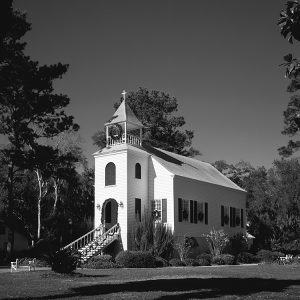
Walk around image – One of the (many) churches in Saint Mary’s, GA
Available here: https://rudy-umans.pixels.com/featured/1st-presbyterian-church-st-marys-2-rudy-umans.html
- The process
Scouting or no scouting
I typically do not go out on a scouting trip. My stomping ground is the Everglades National Park and the Big Cypress National Preserve. There are some other areas in the area I go to occasionally, but most of the time the two I mentioned are pretty much it. I have been going to those places ever since I moved to Miami 35 years ago. Okay, out of those 35 years I lived in Palm Beach for about 15 years after Hurricane Andrew, but I still had ties with Miami all that time and Palm Beach is after all only 1 ½ hours or so driving north of Miami.
In other places, and areas I am not all that familiar with, I don’t really scout either. Usually, there is either no time because I am only there for a very short while and there is simply no opportunity to go to an unfamiliar place, check it out for photo opportunities, and come back another day.
Besides, I think scouting is a bit overrated anyway. I just bring my camera(s) and whatever happens, happens. If I come back to that area at another time, I might see other things or the same thing with different light or whatever and I shoot it then, or I shoot it again (or not) if the circumstances are better. In fact, natural areas tend to change over time. I can scout and find something interesting and a month or so later, it is all changed and not nearly that photogenic anymore or just different. It might be all overgrown, or that tree I liked is simply no longer there. So, I prefer to seize the moment. (That is also my advice to everybody, seize the moment) In the end though, it doesn’t matter much one way or the other.
Fortunately, I don’t shoot from the hip. I shoot mainly large format film and that is never about quantity, but always about quality. So, there is no pressure to come home with lots of pictures. Very often I only shoot 2–4 images in an outing of several hours, and I am usually able to come up with something decent frankly or sometimes even better than decent if I’m lucky. On the other hand, I might also come home with absolutely nothing besides the experience, and that is fine too.
The other thing is that potential subjects just hit me in the head, I can drive or walk around, and with no effort at all something catches my interest. It is almost as if there is a little halo around the darn thing. This doesn’t necessarily mean it will all work out, and I can translate it from a three-dimensional something to a two-dimensional something on a piece of Polyethylene Terephthalate or PET, but at least, the potential is there. These types of photographic revelations are the most fun and are by far my favorites.
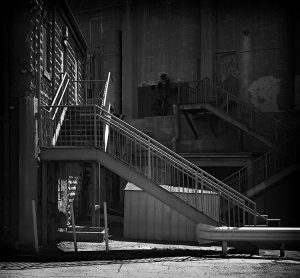
Back entrance of the Coconut Grove playhouse
Available here: https://rudy-umans.pixels.com/featured/coconut-grove-florida-theater-rudy-umans.html
Other than the things that jump out at me, there are some things in the landscape I like to photograph that are on my wish list, but it is either the wrong time of the year, or I can simply not find the exact spot anymore. So even though, it is not scouting per se, there are things I see and keep in the back of my head for another (better) time or for when I can find them again.
“Landscape photography is the supreme test of the photographer – and often the supreme disappointment.” – Ansel Adams
This crooked tree, for instance. It is a relatively famous tree in the Everglades and about 50 feet (15 meters) or so from the main road. I sort of knew where it was, but every time I looked for it, I couldn’t find it until one morning, for some reason it stood out, and I could hear the angels sing. Of course, I seized the moment and spent some quality time with the tree.
Now I lost it again! Like before, I know sort of where it is. It’s playing hide and seek with me. Keep in mind though the tree is only 3 feet (1 meter) tall and surrounded by water and much higher trees, and in my defense, there are also no mile markers in the National Park. I wish they would fix that. I can surely use them. At least I have some halfway decent images of that darn tree now.
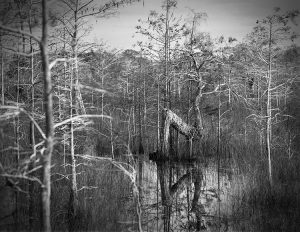
Everglades, Crooked Tree
Available here: https://rudy-umans.pixels.com/featured/perserverance-rudy-umans.html
Feelings
So, let’s assume for a moment I see something I like to photograph, and I need to figure out how. So, what do I do? First, I study the scene in front of me as much as I can and try to figure out why I like what I see. Second, I photographed the Everglades straight on for so long, and at some point, in the not-so-distant past, I decided I needed to do things differently. The Everglades, and nature in general, has so many different aspects and I decided to try to show the magical and mysterious aspects of it all. I always have that on my mind trying to figure things out.
“Ask yourself: “Does this subject move me to feel, think and dream?” – Ansel Adams
I am a guy; do I really have to write about my feelings? I express all my feelings in a picture. That’s not enough? Do you want me to write about it too now? Geez Louise!
All kidding aside, as said, I try to focus on the mystical and spiritual sides of my subjects, especially with my black and white landscape pictures, and to translate what I see to something I would like the viewer of the final product to see, the (potential) subject does have to wake up certain feelings and emotions. If not, there is probably nothing worthwhile to show.
“When I know your soul, I will paint your eyes.” – Amedeo Modigliani
What Modigliani said so elegantly works for photography too. It is my conviction that to capture a subject as good as you can, you must love and understand that subject. Even if it is just for a very brief moment in time, there is this creation of a relationship based on love, understanding, and respect. When I am at that point, I feel a form of intimacy with the subject, regardless of what that subject might be. This form of intimacy is for me more present and pronounced when shooting with film than with digital. I don’t know if it is spiritual, but either way, pretty darn close. As a member of the Bahá’í faith, the second most widespread world religion, I realize that we are all the drops of one ocean and the leaves of one tree. Everything is connected and hopefully, that notion shines through in my work!
How’s that for feelings and all that?
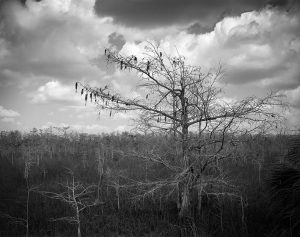
The ominous Everglades
Available here: https://rudy-umans.pixels.com/featured/2-everglades-florida-pond-cypress-trees-5-rudy-umans.html
The inevitable Nitty-gritty
On the other end of the spectrum, the technical part, my pinhole cameras are very different beasts than my wooden field camera, there are fewer technical things to worry about. I need to decide what film and film speed to use. Measure the light with a light meter (sometimes I just wing it), and I need to decide whether to use a contrast-enhancing filter such as a red, orange, or yellow filter for black and white, or no filter. Other than that, I make a few calculations to determine the exposure time, insert the film holder into the camera, make sure the unexposed side faces the front, wait a little bit for any vibrations to die out, and make the exposure. That’s about it.
Using my large format wooden field camera makes things a little more complicated. There are more things to do such as setting up the camera, type of film, what lens, filters or not, where to pinpoint the focus, depth of field (what is sharp and what is not), and, if needed, any perspective corrections (See my “The Goodies” blog) are the main ones.
On average, it takes me about 10–15 minutes to set up my camera, install the lens, install a filter if needed, set initial focus (under a cloth), compose, make any adjustments or perspective corrections, measure the light, set the aperture on the lens for the appropriate Depth of Field, set the shutter speed, check focus for the Depth of Field and final composition, adjust the focus with a 4x or so Lupe, make sure all adjustment knobs are tied down, check focus again to make sure nothing moved during the process, close the lens (open and closing the shutter is a separate operation and enables to keep the lens open independent of the shutter so you can see what you’re doing), cock the shutter (it is a mechanical shutter with springs that needs to be set under tension) click the shutter to make it all works the way it should, cock the shutter again, insert the film holder, pull the dark slide out, click the shutter for real this time, and put the dark slide back in. That’s just about it.
Lots of little steps, but after a while, it becomes second nature, and it is not as dramatic anymore as it was initially. Nevertheless, large format photography is not your average cellphone picture, but I am sure you figured that out already.
The aftershock
So, the shot is made and the holder with the exposed film is put away again. Now what? All that is left now is to break everything down. For me, there is usually a brief moment of mixed emotions. You did it and under different circumstances, it might have been time to smoke that cigarette now. Job well done!
However, you made sure to the best of your abilities that the exposure is perfect and even though you like to think you are, you are never 100% sure. There is always that tiny nagging element of doubt. Anti-climax might be a bit too strong of a term, but every so often it briefly feels that way. At the same time, you are also excited and full of anticipation, and you can’t wait to go home and develop the film. After all, the negative is the goal. It is all about the holy grail, the negative!
Btw, I don’t smoke.
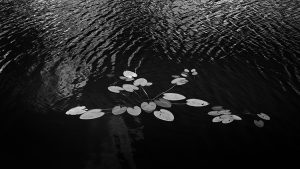
Some water plants in The Everglades National Park
Available here: https://rudy-umans.pixels.com/featured/leaves-on-rippling-waters-rudy-umans.html
- Developing
The negative is in itself not the ultimate goal though. The ultimate goal is to get a perfect negative! Even though Black and White film is forgiving. How much forgiving depends on the sensitivity or ISO (The golden oldies among us might remember DIN or ASA, well, that’s now called ISO), but generally pretty forgiving, Less than perfect negatives can still give you decent, or even good, results in the darkroom or scanning and ink jet printing.
Nevertheless, a perfect negative is the ultimate goal, after all, the better the negative, the less work afterward. With a perfect negative, we mean a negative with good latitude and density. Good highlights that still show some detail, good shadows that also still show some details, and good gray tones in between. The technical term for this is “Density”. Some photographers go to great lengths to get just the right density and when they are done, they measure the density with a densitometer. Personally, I don’t go this far, but once my contact printing gets off the ground, I just might.
When taking the picture, you can manipulate the outcome by metering the exposure a certain way. One can meter for the highlights, more for the shadows, or just the average, and either way influences the outcome. With developing film, one can manipulate the contrast by using different developers (chemicals), different developing times, or even different water temperatures, for instance.
It is beyond the scope of this article to go into too much detail, just remember that exposure and developing go hand in hand to create “The Perfect Negative”. In other words, how you want your viewers to perceive the subject you so carefully captured in the field or studio is determined both on location and in the darkroom, your kitchen, or bathroom if you don’t have a permanent darkroom.
Before I started to develop my own film, I used to send it out to a lab and even though they did an okay job, it was expensive and not very satisfying. Now I develop my own film, and it is not only a huge money saver (especially with 8 × 10” film), but also hugely satisfying. It almost makes the process complete (more about that next). Shooting large format sheet film (4 × 5” and up) has the additional advantage that you can develop one sheet at the time, and you can tailor make each and every negative, unlike with roll film where you have no choice but to develop anywhere between 4 and 36 exposures at the same time.
“Photography is not about what you see or how you see it, but about how you want to present it.” – Me
- Scanning, Post Processing, and Printing
Some people are lucky and have the space for an actual old-school darkroom that allows them to process and print their negatives the time-honored way. I am not one of those people. Like so many mortals, I have to resort to scanning and digital printing. I wish I had a darkroom, but I do not, and I have to row with the oars that were given to me. Not as much fun as a real darkroom, but we try to make the best of it. As a consolation, I know quite a few famous analog photographers who do the same thing, they scan and print on ink jet printers and everybody is happy, and if they can be happy with it, who are we?
My scanning routine is simple, with large format I have two options, I either source it out to a company or an individual with a drum scanner, which can yield excellent results, but is also very expensive. The other option is a flatbed scanner (like an old-school document scanner, but better). Considering my limited financial resources, I opted for option two. I use a flatbed scanner with dedicated software. I leave most of the scanning software at either neutral or at the default settings.
There is also not much post-processing. Black and White photographs are all about contrast and that’s what I do, correcting the contrast. Just like what was always done in the darkroom. I dodge (make lighter) what is needed, and I Burn (make darker) what is needed. Usually, I crop the image a little to clean the edges, and I do some housekeeping if there are spots or specks of dust visible, which is usually not much since I started to develop myself. When I still outsourced the developing, dust spots and things were a real problem occasionally.
All that is left is printing. As of this writing, I still print with an ink jet printer and pigment ink, but very soon, I will start contact printing following one of the old school processes. With these printing techniques, you have to make your own light sensitive emulsion, paint it on a piece of paper, and expose it under UV light (Either artificial or the sun)
Talking about scanning and printing techniques becomes technical pretty quickly, which would defeat the purpose of this blog post. I don’t want to go there right now, it would be too much, and you know what they say, too much of a good thing is not good. Maybe I will write a future blog post about the whole scanning and printing process, papers, inks, and the whole kit in a bottle if people ask for it.
- Why bother?
Why would a person who doesn’t drink alcohol, who doesn’t smoke, drinks one cup of coffee a day, and is presumably reasonably sane go through all this trouble to get one picture?
Some people might answer a question like this with “I ask that myself every single day”, but I am not one of those people. I know why I bother, it’s just a little challenging to put it into words, so bear with me.
There are several reasons; You enjoy the Zen of the whole ritual, you have this rebellious feeling to get away from the crowd pleasers, and you’re not necessarily a leader, but you would rather not be a follower either. If you try to sell your images, you want a competitive edge, or you just want to be different.
I guess that all these reasons apply to me and, most likely, also to the majority of people who do more or less the same things as I do. Obviously, I am not the only one who enjoys these branches of photography.
If I just stick to landscape photography, what I do most, I can say that landscape photography is easy in many ways, but equally difficult in just as many ways. I guess landscape images have certain preconceptions among the public, and it’s difficult to stay true to yourself. It is difficult to blindly follow the fashion of the day, like overly bold sunsets, composition clichés, or perfect travel book/website images. To me, it looks like these types of images are trying to sell something, like a service or a product. Photography always had fads. Remember “The Dutch Angle”, where the photos or motion pictures were all crooked and had weird angles? That fad came and went, and so will all the other fads eventually.
Old-fashioned craftsmanship though is not a fad, and will always be appreciated by a good chunk of the population. The Arts and Crafts movement is still in style after 155 years. That’s one reason we do this, we don’t want it to die. In my Hometown, there is a castle that belonged to Napoleon III (He called it “a cottage”). This castle has blue-tinted windows, and nobody today can figure out how they made those. That is such a shame. The other sad part is that those windows are not the only lost art, there are so many century old things of which nobody knows anymore how they were made.
Especially with the arrival of digital photography, I feel that photography is rapidly declining. It gets easier and easier to produce a good-looking image. I said it before, preset filters, AI, and automated features in software applications are all nails in the coffin of Photography as a craft and as an art. Although sad, it is what it is and as long as there are people who still appreciate and exercise the true arts and crafts of photography, we might be okay for today’s generation and generations to come.
So, that’s one reason; the preservation of photography.
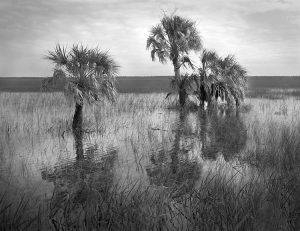
After the rain
available here: https://rudy-umans.pixels.com/featured/lonely-palm-trees-rudy-umans.html
The other main reason is the “Zen” of it all.
There is something about working with beautifully handmade equipment, they demand a level of respect and patience. Equipment like that forces one to slow down and think about what you want to capture and how you would want to capture it. Sure, it is also heavy and cumbersome from time to time, but to use a cliché, that only adds to the charm. The thing with clichés is that they are usually true. That’s why they became a cliché in the first place. All the decisions in the image making process must be made by the photographer. Nothing is automatic. This whole process of creating something is very satisfying regardless of the results. Even the mistakes have a purpose and there is nobody to blame but yourself. (and believe me, I made plenty if not all)
The icing on the cake is a beautiful print. As John Sexton puts it so elegantly; “If it is not printed, it is not a photograph”. I couldn’t agree more. An image on your hard drive is just a bunch of ones and zeros, there is no real image.
Can you imagine what it feels like to print something in a darkroom, or better, printed with a time honored printing method where you must paint the emulsion on a piece of paper first? A process that is almost as old as photography itself! A truly handmade from A-Z photograph for generations to enjoy! Can’t wait to start!
This post is also published on my personal site: www.rudyumans.com
Rudy Umans
Monday, September 23, 2024
Some disclaimers
All the images were captured on film with minimal post-processing.
Also, the above are strictly my personal opinions and experiences. There are no claims of the truth here and your milage might vary.
This essay was 100% written by me, and that includes all the typos and grammar mistakes that only humans are allowed to make. No Artificial Intelligence was used.
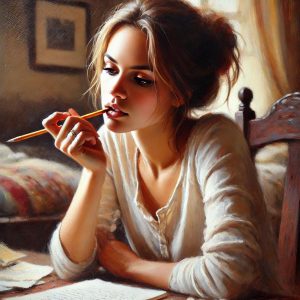
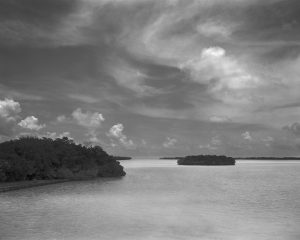
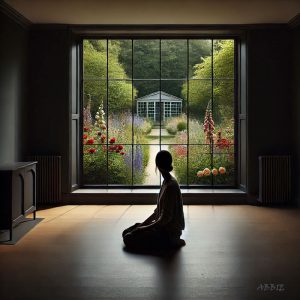
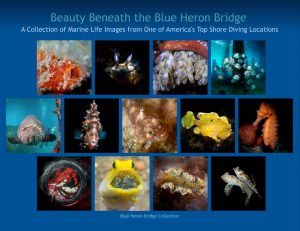





› Forums › The Inside Out Photograph
Tagged: devloping, Everglades, EXPRESSIONS, feelings, Photography, process, scouting
The inside-out photograph
Some time ago, I asked on social media if there were any subjects people wanted me to write about. I got several suggestions and two of them stood out for me. One was in the form of a question that at first sight looked straightforward. Now, I have had straightforward questions before in my life, and they were rarely ever “straightforward”. Some of them might have been the hardest questions people ever asked me. This one was no exception.
The suggestion was “Life as a photographer. The daily click. How many clicks to a picture? One-click discipline. How is a photo found or conceived? How do you express feelings in photographs? What is the process leading to the click?”
Another one was “How about looking at the idea of expressing feeling through photographs?” as suggested by
Here are the actual suggestions (verbatim)
Andrew B
“How about looking at the idea of expressing feeling through photographs – Stieglitz then Minor White led with it – compare and contrast with just “photographing to see what something looks like photographed”
Cheryl S
“Life as a photographer. The daily click. How many clicks to a pic that is it. One click discipline. How is a photo found or conceived. What is the process leading to the click.”
Honestly, I had to think about both of these for a while. It wasn’t like their suggestions were easy ones. When I read them, it was as if they were asking me to summarize the meaning and the impact of the Bible in 5 pages or so. Good luck with that! Anyway, I decided to combine the two into the blog post that you are reading right now.
I will go over the whole process of creating a purposely made photograph. Purposely, rather than a snapshot. From getting the “itchies” as I call it, to the finished image, and not just the technical side of things, but more about the why and how, hopefully.
It is not just about taking pictures, it is also about being out and about in nature or the need to give my brain a break from all the excitements of daily life. People have all sorts of ways of doing that. They play sports, have a hobby of some sort, or sleep on the couch on their day off.
For me, it is creating art. Photography is my chosen form of creating, but frankly, I could easily have been a potter, a painter, a woodworker, a glassblower, or a weaver. I am fascinated by all of those. But as we know, photography it is.
Being creative is good for everyone and good for mankind as a whole. Each individual effort helps with the growth and progress of mankind. I’m not sure what the world would look like without creativity, but I have a feeling none of us would like it. Talented or not is completely irrelevant.
“Practice any art, music, singing, dancing, acting, drawing, painting, sculpting, poetry, fiction, essays, reportage, no matter how well or badly, not to get money and fame, but to experience becoming, to find out what’s inside you, to make your soul grow.” – Kurt Vonnegut
So, if life was too time-consuming for a while and I didn’t have the opportunity to be creative with my photography, it’s like all my muscles are beginning to tighten up and my nerves are beginning to burn. Not literally, obviously, but it surely feels like it. I call that the “itchies”. It is that urge that wants me to get out and that wants me to come home with my next “masterpiece”, but the older I get, the more time-consuming life seems to become at certain times of the year.
Here is the thing though, I simply cannot come home with halfway decent images if I am too tense, and I have too much on my mind. Photography is for me not a way to relax. It is not a way to get rid of all that tension. Just being in nature probably is, but not if I go out with the purpose of photographing. For me to come home with something decent, I need to be relaxed before I leave home. If I get the itchies, I work harder to get all the chores and errands done. That complicated letter that needs to be written, for instance, has to be written before I can go out and remotely hope to have a successful photography outing. In other words, my “itchies” are very motivational to get things done. If I know I have a pile of work that must be done, I cannot relax since that pile of work would be all I would be thinking of if I am out and about.
“12 significant photographs in any one year is a good crop.” – Ansel Adams
I know a big thing with my type of photography, analog landscapes, is weather-dependent. In many instances, it is a waiting game. Waiting for the right weather, the right clouds, and the right light. Living in South Florida, I don’t have that problem very often. Many days are just about the same. A week or two can go by without a significant change in the weather. Meaning, that for my “Itchies” problem, weather is usually not the most significant factor, if a factor at all. If I must wait for the weather, it is more often than not, waiting for the weather to get worse. I prefer drama in my work, and bad weather and big clouds can give that to me.
Walk around image – One of the (many) churches in Saint Mary’s, GA
Available here: https://rudy-umans.pixels.com/featured/1st-presbyterian-church-st-marys-2-rudy-umans.html
Scouting or no scouting
I typically do not go out on a scouting trip. My stomping ground is the Everglades National Park and the Big Cypress National Preserve. There are some other areas in the area I go to occasionally, but most of the time the two I mentioned are pretty much it. I have been going to those places ever since I moved to Miami 35 years ago. Okay, out of those 35 years I lived in Palm Beach for about 15 years after Hurricane Andrew, but I still had ties with Miami all that time and Palm Beach is after all only 1 ½ hours or so driving north of Miami.
In other places, and areas I am not all that familiar with, I don’t really scout either. Usually, there is either no time because I am only there for a very short while and there is simply no opportunity to go to an unfamiliar place, check it out for photo opportunities, and come back another day.
Besides, I think scouting is a bit overrated anyway. I just bring my camera(s) and whatever happens, happens. If I come back to that area at another time, I might see other things or the same thing with different light or whatever and I shoot it then, or I shoot it again (or not) if the circumstances are better. In fact, natural areas tend to change over time. I can scout and find something interesting and a month or so later, it is all changed and not nearly that photogenic anymore or just different. It might be all overgrown, or that tree I liked is simply no longer there. So, I prefer to seize the moment. (That is also my advice to everybody, seize the moment) In the end though, it doesn’t matter much one way or the other.
Fortunately, I don’t shoot from the hip. I shoot mainly large format film and that is never about quantity, but always about quality. So, there is no pressure to come home with a lot of pictures. Very often I only shoot 2–4 images in an outing of several hours, and I am usually able to come up with something decent frankly or sometimes even better than decent if I’m lucky. On the other hand, I might also come home with absolutely nothing besides the experience, and that is fine too.
The other thing is that potential subjects just hit me in the head, I can drive or walk around, and with no effort at all something catches my interest. It is almost as if there is a little halo around the darn thing. This doesn’t necessarily mean it will all work out, and I can translate it from a three-dimensional something to a two-dimensional something on a piece of Polyethylene Terephthalate or PET, but at least, the potential is there. These types of photographic revelations are the most fun and are by far my favorites.
Back entrance of the Coconut Grove playhouse
Available here: https://rudy-umans.pixels.com/featured/coconut-grove-florida-theater-rudy-umans.html
Other than the things that jump out at me, there are some things in the landscape I like to photograph that are on my wish list, but it is either the wrong time of the year, or I can simply not find the exact spot anymore. So even though, it is not scouting per se, there are things I see and keep in the back of my head for another (better) time or for when I can find them again.
“Landscape photography is the supreme test of the photographer – and often the supreme disappointment.” – Ansel Adams
This crooked tree, for instance. It is a relatively famous tree in the Everglades and about 50 feet (15 meters) or so from the main road. I sort of knew where it was, but every time I looked for it, I couldn’t find it until one morning, for some reason it stood out, and I could hear the angels sing. Of course, I seized the moment and spent some quality time with the tree.
Now I lost it again! Like before, I know sort of where it is. It’s playing hide and seek with me. Keep in mind though the tree is only 3 feet (1 meter) tall and surrounded by water and much higher trees, and in my defense, there are also no mile markers in the National Park. I wish they would fix that. I can surely use them. At least I have some halfway decent images of that darn tree now.
Everglades, Crooked Tree
Available here: https://rudy-umans.pixels.com/featured/perserverance-rudy-umans.html
Feelings
So, let’s assume for a moment I see something I like to photograph, and I need to figure out how. So, what do I do? First, I study the scene in front of me as much as I can and try to figure out why I like what I see. Second, I photographed the Everglades straight on for so long, and at some point, in the not-so-distant past, I decided I needed to do things differently. The Everglades, and nature in general, has so many different aspects and I decided to try to show the magical and mysterious aspects of it all. I always have that on my mind trying to figure things out.
“Ask yourself: “Does this subject move me to feel, think and dream?” – Ansel Adams
I am a guy; do I really have to write about my feelings? I express all my feelings in a picture. That’s not enough? Do you want me to write about it too now? Geez Louise!
All kidding aside, as said, I try to focus on the mystical and spiritual sides of my subjects, especially with my black and white landscape pictures, and to translate what I see to something I would like the viewer of the final product to see, the (potential) subject does have to wake up certain feelings and emotions. If not, there is probably nothing worthwhile to show.
“When I know your soul, I will paint your eyes.” – Amedeo Modigliani
What Modigliani said so elegantly works for photography too. It is my conviction that to capture a subject as good as you can, you must love and understand that subject. Even if it is just for a very brief moment in time, there is this creation of a relationship based on love, understanding, and respect. When I am at that point, I feel a form of intimacy with the subject, regardless of what that subject might be. This form of intimacy is for me more present and pronounced when shooting with film than with digital. I don’t know if it is spiritual, but either way, pretty darn close. As a member of the Bahá’í faith, the second most widespread world religion, I realize that we are all the drops of one ocean and the leaves of one tree. Everything is connected and hopefully, that notion shines through in my work!
How’s that for feelings and all that?
The ominous Everglades
Available here: https://rudy-umans.pixels.com/featured/2-everglades-florida-pond-cypress-trees-5-rudy-umans.html
The inevitable Nitty-gritty
On the other end of the spectrum, the technical part, my pinhole cameras are very different beasts than my wooden field camera, there are fewer technical things to worry about. I need to decide what film and film speed to use. Measure the light with a light meter (sometimes I just wing it), and I need to decide whether to use a contrast-enhancing filter such as a red, orange, or yellow filter for black and white, or no filter. Other than that, I make a few calculations to determine the exposure time, insert the film holder into the camera, make sure the unexposed side faces the front, wait a little bit for any vibrations to die out, and make the exposure. That’s about it.
Using my large format wooden field camera makes things a little more complicated. There are more things to do such as setting up the camera, type of film, what lens, filters or not, where to pinpoint the focus, depth of field (what is sharp and what is not), and, if needed, any perspective corrections (See my “The Goodies” blog) are the main ones.
On average, it takes me about 10–15 minutes to set up my camera, install the lens, install a filter if needed, set initial focus (under a cloth), compose, make any adjustments or perspective corrections, measure the light, set the aperture on the lens for the appropriate Depth of Field, set the shutter speed, check focus for the Depth of Field and final composition, adjust the focus with a 4x or so Lupe, make sure all adjustment knobs are tied down, check focus again to make sure nothing moved during the process, close the lens (open and closing the shutter is a separate operation and enables to keep the lens open independent of the shutter so you can see what you’re doing), cock the shutter (it is a mechanical shutter with springs that needs to be set under tension) click the shutter to make it all works the way it should, cock the shutter again, insert the film holder, pull the dark slide out, click the shutter for real this time, and put the dark slide back in. That’s just about it.
Lots of little steps, but after a while, it becomes second nature, and it is not as dramatic anymore as it was initially. Nevertheless, large format photography is not your average cellphone picture, but I am sure you figured that out already.
The aftershock
So, the shot is made and the holder with the exposed film is put away again. Now what? All that is left now is to break everything down. For me, there is usually a brief moment of mixed emotions. You did it and under different circumstances, it might have been time to smoke that cigarette now. Job well done!
However, you made sure to the best of your abilities that the exposure is perfect and even though you like to think you are, you are never 100% sure. There is always that tiny nagging element of doubt. Anti-climax might be a bit too strong of a term, but every so often it briefly feels that way. At the same time, you are also excited and full of anticipation, and you can’t wait to go home and develop the film. After all, the negative is the goal. It is all about the holy grail, the negative!
Btw, I don’t smoke.
Some water plants in The Everglades National Park
Available here: https://rudy-umans.pixels.com/featured/leaves-on-rippling-waters-rudy-umans.html
The negative is in itself not the ultimate goal though. The ultimate goal is to get a perfect negative! Even though Black and White film is forgiving. How much forgiving depends on the sensitivity or ISO (The golden oldies among us might remember DIN or ASA, well, that’s now called ISO), but generally pretty forgiving, Less than perfect negatives can still give you decent, or even good, results in the darkroom or scanning and ink jet printing.
Nevertheless, a perfect negative is the ultimate goal, after all, the better the negative, the less work afterward. With a perfect negative, we mean a negative with good latitude and density. Good highlights that still show some detail, good shadows that also still show some details, and good gray tones in between. The technical term for this is “Density”. Some photographers go to great lengths to get just the right density and when they are done, they measure the density with a densitometer. Personally, I don’t go this far, but once my contact printing gets off the ground, I just might.
When taking the picture, you can manipulate the outcome by metering the exposure a certain way. One can meter for the highlights, more for the shadows, or just the average, and either way influences the outcome. With developing film, one can manipulate the contrast by using different developers (chemicals), different developing times, or even different water temperatures, for instance.
It is beyond the scope of this article to go into too much detail, just remember that exposure and developing go hand in hand to create “The Perfect Negative”. In other words, how you want your viewers to perceive the subject you so carefully captured in the field or studio is determined both on location and in the darkroom, your kitchen, or bathroom if you don’t have a permanent darkroom.
Before I started to develop my own film, I used to send it out to a lab and even though they did an okay job, it was expensive and not very satisfying. Now I develop my own film, and it is not only a huge money saver (especially with 8 × 10” film), but also hugely satisfying. It almost makes the process complete (more about that next). Shooting large format sheet film (4 × 5” and up) has the additional advantage that you can develop one sheet at the time, and you can tailor make each and every negative, unlike with roll film where you have no choice but to develop anywhere between 4 and 36 exposures at the same time.
“Photography is not about what you see or how you see it, but about how you want to present it.” – Me
Some people are lucky and have the space for an actual old-school darkroom that allows them to process and print their negatives the time-honored way. I am not one of those people. Like so many mortals, I have to resort to scanning and digital printing. I wish I had a darkroom, but I do not, and I have to row with the oars that were given to me. Not as much fun as a real darkroom, but we try to make the best of it. As a consolation, I know quite a few famous analog photographers who do the same thing, they scan and print on ink jet printers and everybody is happy, and if they can be happy with it, who are we?
My scanning routine is simple, with large format I have two options, I either source it out to a company or an individual with a drum scanner, which can yield excellent results, but is also very expensive. The other option is a flatbed scanner (like an old-school document scanner, but better). Considering my limited financial resources, I opted for option two. I use a flatbed scanner with dedicated software. I leave most of the scanning software at either neutral or at the default settings.
There is also not much post-processing. Black and White photographs are all about contrast and that’s what I do, correcting the contrast. Just like what was always done in the darkroom. I dodge (make lighter) what is needed, and I Burn (make darker) what is needed. Usually, I crop the image a little to clean the edges, and I do some housekeeping if there are spots or specks of dust visible, which is usually not much since I started to develop myself. When I still outsourced the developing, dust spots and things were a real problem occasionally.
All that is left is printing. As of this writing, I still print with an ink jet printer and pigment ink, but very soon, I will start contact printing following one of the old school processes. With these printing techniques, you have to make your own light sensitive emulsion, paint it on a piece of paper, and expose it under UV light (Either artificial or the sun)
Talking about scanning and printing techniques becomes technical pretty quickly, which would defeat the purpose of this blog post. I don’t want to go there right now, it would be too much, and you know what they say, too much of a good thing is not good. Maybe I will write a future blog post about the whole scanning and printing process, papers, inks, and the whole kit in a bottle if people ask for it.
Why would a person who doesn’t drink alcohol, who doesn’t smoke, drinks one cup of coffee a day, and is presumably reasonably sane go through all this trouble to get one picture?
Some people might answer a question like this with “I ask that myself every single day”, but I am not one of those people. I know why I bother, it’s just a little challenging to put it into words, so bear with me.
There are several reasons; You enjoy the Zen of the whole ritual, you have this rebellious feeling to get away from the crowd pleasers, and you’re not necessarily a leader, but you would rather not be a follower either. If you try to sell your images, you want a competitive edge, or you just want to be different.
I guess that all these reasons apply to me and, most likely, also to the majority of people who do more or less the same things as I do. Obviously, I am not the only one who enjoys these branches of photography.
If I just stick to landscape photography, what I do most, I can say that landscape photography is easy in many ways, but equally difficult in just as many ways. I guess landscape images have certain preconceptions among the public, and it’s difficult to stay true to yourself. It is difficult to blindly follow the fashion of the day, like overly bold sunsets, composition clichés, or perfect travel book/website images. To me, it looks like these types of images are trying to sell something, like a service or a product. Photography always had fads. Remember “The Dutch Angle”, where the photos or motion pictures were all crooked and had weird angles? That fad came and went, and so will all the other fads eventually.
Old-fashioned craftsmanship though is not a fad, and will always be appreciated by a good chunk of the population. The Arts and Crafts movement is still in style after 155 years. That’s one reason we do this, we don’t want it to die. In my Hometown, there is a castle that belonged to Napoleon III (He called it “a cottage”). This castle has blue-tinted windows, and nobody today can figure out how they made those. That is such a shame. The other sad part is that those windows are not the only lost art, there are so many century old things of which nobody knows anymore how they were made.
Especially with the arrival of digital photography, I feel that photography is rapidly declining. It gets easier and easier to produce a good-looking image. I said it before, preset filters, AI, and automated features in software applications are all nails in the coffin of Photography as a craft and as an art. Although sad, it is what it is and as long as there are people who still appreciate and exercise the true arts and crafts of photography, we might be okay for today’s generation and generations to come.
So, that’s one reason; the preservation of photography.
After the rain
available here: https://rudy-umans.pixels.com/featured/lonely-palm-trees-rudy-umans.html
The other main reason is the “Zen” of it all.
There is something about working with beautifully handmade equipment, they demand a level of respect and patience. Equipment like that forces one to slow down and think about what you want to capture and how you would want to capture it. Sure, it is also heavy and cumbersome from time to time, but to use a cliché, that only adds to the charm. The thing with clichés is that they are usually true. That’s why they became a cliché in the first place. All the decisions in the image making process must be made by the photographer. Nothing is automatic. This whole process of creating something is very satisfying regardless of the results. Even the mistakes have a purpose and there is nobody to blame but yourself. (and believe me, I made plenty if not all)
The icing on the cake is a beautiful print. As John Sexton puts it so elegantly; “If it is not printed, it is not a photograph”. I couldn’t agree more. An image on your hard drive is just a bunch of ones and zeros, there is no real image.
Can you imagine what it feels like to print something in a darkroom, or better, printed with a time honored printing method where you must paint the emulsion on a piece of paper first? A process that is almost as old as photography itself! A truly handmade from A-Z photograph for generations to enjoy! Can’t wait to start!
Rudy Umans
Monday, September 23, 2024
Some disclaimers
All the images were captured on film with minimal post-processing.
Also, the above are strictly my personal opinions and experiences. There are no claims of the truth here and your milage might vary.
This essay was 100% written by me, and that includes all the typos and grammar mistakes that only humans are allowed to make. No Artificial Intelligence was used.
Post Permalink – https://ourartsmagazine.com/blog/2024/09/24/the-inside-out-photograph/